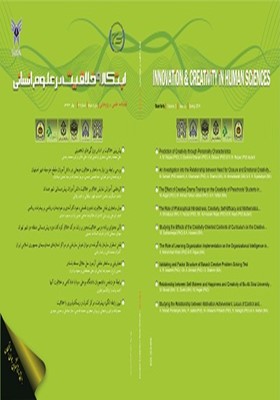تأثیر محتوای برنامهٔ درسی خلاقیتمحور بر رشد درک خلاق کودکان دورهٔ پیشدبستانی منطقه دو شهر تهران
محورهای موضوعی : خلاقیت و نوآوری از جنبه‏های روان‏شناختی، علوم شناختی، علوم تربیتی و آموزشی (خلاقیت شناسی روان‏شناختی، خلاقیت شناسی پرورشی)مهدی سبحانی نژاد 1 , اشرف السادات حسینی 2 *
1 - استاد دانشگاه شاهد sobhaninejad@shahed.ac.ir
2 - فارغالتحصیل کارشناسی ارشد (نویسندة مسئول) a_hosseini7007@yahoo.com
کلید واژه: خلاقیت, درک خلاق, برنامهٔ درسی خلاقیتمحور, پیشدبستان, تجربی مقدماتی, تورنس,
چکیده مقاله :
زمینه: امروزه بدیهی است که خلاقیت آموزش دادنی است و مختص برخی اشخاص نیست. هدف: هدف پژوهش حاضر، تعیین تأثیر محتوای برنامه درسی خلاقیت محور، بر رشد درک خلاق کودکان پیشدبستانی منطقه دو شهر تهران بوده است. روش پژوهش: روش پژوهش، از نوع تجربی مقدماتی یا طرح یک گروهی پیشآزمون- پسآزمون، است. جامعه آماری این پژوهش شامل، کلیه کودکان پیشدبستانی منطقه دو شهر تهران، با جمعیتی بالغبر 2433 نفر بوده است. از بین مناطق جامعه آماری موردنظر، منطقه دو و از بین مجموعه مراکز پیشدبستانی آن منطقه، یک مرکزپیشدبستانی بهتصادف انتخاب و در مرکز مذکور، کلاس پیشدبستانی دو، شامل 18 دانشآموز دختر و پسر، بهعنوان نمونه پژوهش انتخاب شدند. یافتههای پژوهش: اجرای طرح برنامه درسی خلاقیت محور بر رشد درک خلاق کودکان دوره پیشدبستانی در بعدهای سیالی و ابتکار تأثیر معنادار مثبت داشته است. از سوی دیگر، اجرای طرح برنامه درسی خلاقیت محور بر رشد درک خلاق کودکان پیشدبستانی در بعد تخیل، تأثیر معناداری نداشته است. نتیجهگیری: درنهایت، فرضیه اصلی مبنی بر تأثیر اجرای طرح برنامه درسی خلاقیت محور بر رشد درک خلاق کودکان پیشدبستانی در دو بعد سیالی و ابتکار تأیید گردید که نشانگر تأثیر مثبت برنامهٔ مذکور بر میزان خلاقیت کودکان در جامعة یادشده است.
Background: Today it is found that creativity is teachable and this means that creativity is not specific to some particular individuals. Objective(s): This article studied the effects of the creativity-oriented contents of lesson plan (curriculum) on the growth of the creative understanding of the preschool children in the second district zone of the city of Tehran. Method(s): The method of this study was preliminary experimental or one-group pretest-post-test design. The study population included all preschool children in the second district of Tehran, with a population of over 2433. One center was randomly selected from all preschool centers that exist in the area. In that center, the preschool class number two - included 18 boys and girls - was selected as sample. Result(s): Results showed that: The amount of preschool children creativity in fluency in the post-test was higher than the pre-test significantly; And also, in originality in the post-test was higher than the pre-test significantly; which represents the effect of creativity-oriented lesson plan (curriculum) contents on preschool children’s creative understanding growth in fluency and originality. On the other hand, there was no significant difference in the amount of preschool children creativity in imagination in the post-test and the pre-test; which represents no effect of creativity-oriented lesson plan (curriculum) contents on preschool children’s creative understanding growth in imagination. Conclusion: At the end, the amount of preschool children creativity in the post-test was higher than the pre-test significantly; which represents the effect of creativity-oriented lesson plan (curriculum) contents on preschool children’s creative understanding growth.

